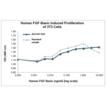| Alternative Name: | FGF2, HBGF-2, Prostatropin |
| |
| MW: | ~16.5kDa |
| |
| Source: | Produced in E. coli. Non-glycosylated protein, containing 147 amino acids. |
| |
| UniProt ID: | P09038 |
| |
| Formulation: | Lyophilized from 10mM sodium phosphate, 75mM sodium chloride, pH 7.5. Sterile filtered. |
| |
| Purity: | ≥95% using Coomassie Staining |
| |
| Endotoxin Content: | ≤0.1 EU/µg using USP <85>/EP 2.6.14 |
| |
| Appearance: | White lyophilized (freeze-dried) powder. |
| |
| Biological Activity: | ≤5 ng/mL. The ED50 determined by NR6R-3T3 cell proliferation assay |
| |
| Reconstitution: | When reconstituting the product, gently pipet and wash down the sides of the vial to ensure full recovery of the protein into solution. It is recommended to reconstitute the lyophilized product with sterile water at a concentration of 0.1 mg/ml, which can be further diluted into other aqueous solutions. |
| |
| Shipping: | Ambient Temperature |
| |
| Long Term Storage: | -80°C |
| |
| Use/Stability: | It is recommended that working aliquots to be diluted in a 0.1% BSA solution for long term storage. |
| |
| Handling: | Centrifuge the vial before opening the cap. After reconstitution, prepare aliquots and store at -80°C and avoid repeat freeze thaws. |
| |
| Scientific Background: | Fibroblast growth factors (FGFs) are a 22 member family of proteins known to be involved in angiogenesis, wound healing and embryonic development. As a family, they bind to heparin and signal through four receptor tyrosine kinases called, FGFR1, 2, 3 and 4. Although the mechanism remains unclear, FGF-basic 147 (variant of FGF basic 154), also called FGF-2, is a critical component in keeping embryonic stem cells undifferentiated in cell culture systems. |
| |
| Regulatory Status: | RUO - Research Use Only |
| |














